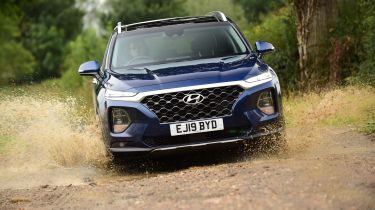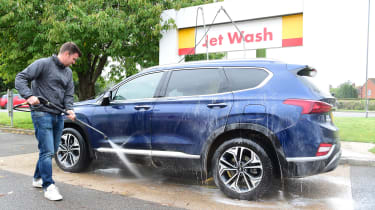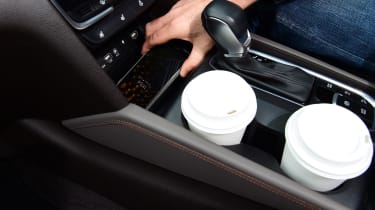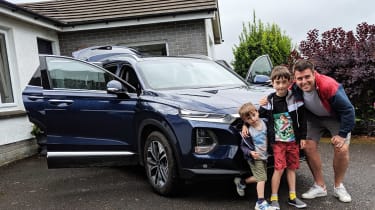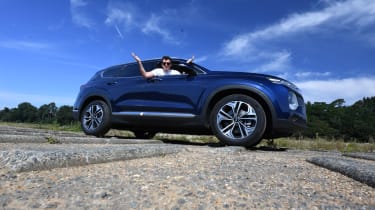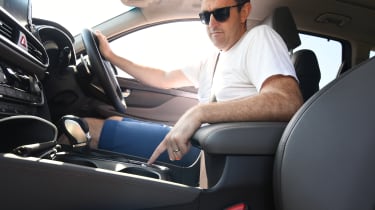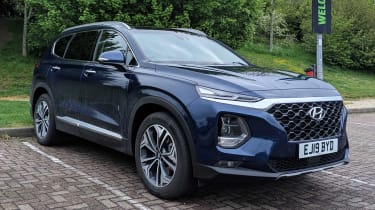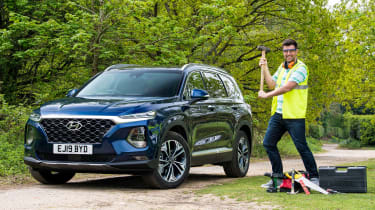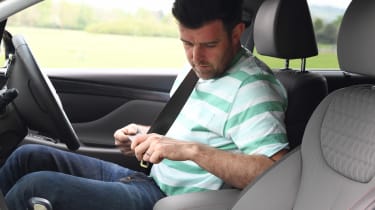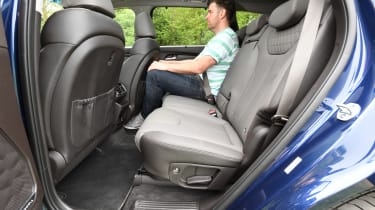Hyundai Santa Fe Premium SE: long-term test
Final report: Hyundai Santa Fe is a fine family car, but surprisingly expensive
Concerns about the lofty price tag of the Hyundai Santa Fe have proven to be unfounded because the big SUV showed its quality and class over six months. It’s a mark of how polished Hyundai products have become.
Mileage: 6,253 Economy: 39.7mpg
Our Santa Fe is going soon, and it will leave a big blue SUV-shaped hole in Walker family life. I find it helps on solemn occasions such as this to look back to the time of the departing party’s arrival and try to gauge the impact it’s had.
I had a few preconceptions about the Santa Fe before it arrived, probably similar to those harboured by many car buyers and rooted in both previous experience of Hyundais and a knowledge of the brand.
Over its years in the UK, what the Korean firm has conditioned us to expect is good value, a competitive price that gets you lots of equipment, a long warranty and a car that’s not going to upset anyone too much.
The Santa Fe’s main impact on me has been to politely suggest that Hyundai is fast becoming better than all that. For a start, our car isn’t particularly cheap. At £43,320, this fully loaded Premium SE model costs more than many core seven-seat SUV rivals that have powerful diesel engines, automatic gearboxes and similarly comprehensive equipment lists. Look at the SEAT Tarraco Xcellence Lux at £38,305 and Peugeot 5008 GT at £39,985 for proof of that.
Used - available now

2016 Hyundai
Santa FE
33,953 milesManualDiesel2.2L
Cash £15,500
2023 Hyundai
Santa FE
19,237 milesAutomaticPetrol1.6L
Cash £29,200
2015 Hyundai
Santa FE
120,547 milesManualDiesel2.2L
Cash £7,052
2020 Hyundai
Santa FE
36,860 milesAutomaticDiesel2.2L
Cash £26,299The Santa Fe is also better built than you’d imagine, using materials that give a whiff of class to the interior that you may not have been expecting. The kids did manage to dislodge one of the hooks for the rear sun blinds, but that was the only breakage while we had the car. The rest of the cabin still looks pristine after six months’ hard use.
In short, there’s a level of polish to the way the Hyundai goes about its business that means it’s easily good enough to be judged on equal terms with the best in its class.
Of course, this opens up its own set of problems. In particular, it’s that much harder to overlook a car’s foibles when the manufacturer is charging a high price for it, and the Santa Fe is far from perfect.
For example, the eight-speed automatic box is slow to respond, and that combines with the stop-start system to make pulling out of junctions more of a drama than it needs to be. Too often, you prod the throttle to get the car moving, but by the time the Santa Fe lurches forward, that once-distant double-decker bus is bearing down on you.
Then there’s the lane-keep assist system. You can turn it off, but it comes back to haunt you every time you start the car. It’s not a problem on wide, sweeping roads but the B-roads near my house have it beeping every time I flirt with a white line, and the tugging on the steering soon gets tiresome.
In other respects, the Santa Fe has been a pleasure to use. It’s really spacious for a family of four, even with holiday luggage on board, and the seven-seat system is brilliantly simple to use – with electric mechanisms to fold some of the rear seats.
The seats also move and clip into place with a lovely solid action that suggests they’re going to last the course well. Adults can just about squeeze into the third row, too. And, while we haven’t subjected any to the experience for more than a few minutes, when we did there was still enough luggage space behind for a couple of soft bags.
• Best seven-seat cars available
The engine is impressively quiet and economy only slipped out of the 38-43mpg window briefly – meaning our economy was almost identical to the official 39.8mpg.
What we haven’t done is tested the Santa Fe’s off-road abilities on anything more than a puddle-strewn track, but that’s much like most owners. Whatever you feel about SUVs being used as urban runabouts, it’s hard to argue that they aren’t any good at it.
Hyundai Santa Fe: fourth report
Our Hyundai Santa Fe SUV gets a thorough test on a family holiday
Mileage: 5,710Economy: 37.8mpg
There’s nothing like a relaxing family holiday to put cruel and unusual pressure on the family car, and that’s exactly what our Hyundai Santa Fe has just been subjected to. The £43,320 SUV is well bedded into the daily routine but a two-week family break in the south west pushed it out of its comfort zone.
It’s a model that’s great from a practicality standpoint: there’s loads of room for luggage and enough space in the back seats to stop the kids getting narky. If you need to charge tablets, phones, DVD players and run coolboxes, you really are spoilt for choice, with sockets in the boot plus USB charging points for the rear seats and, usefully, a two-pin socket to which you can connect a continental adapter. Then there’s a wireless charging mat and more USBs in the front. Hyundai knows how families work.
We made use of the rear-seat sun blinds for our youngest, but one of the plastic hooks to secure the blind at the top of the frame snapped.
The Santa Fe is a very comfortable cruiser, smooth and impressively refined at speed, but Cornwall’s narrow lanes highlighted issues with the powertrain that we’ve mentioned before. The eight-speed box and stop-start system really struggle to get their act together when you need to pull quickly away from standstill, while the winding, hilly roads played havoc with the fuel economy.
On the other hand, the Santa Fe is composed for a seven-seat SUV, managing not to turn to jelly when shown a corner. The well weighted steering is good, but I turn off the lane-keep assist before any trip that isn’t mainly motorway. Its constant bleeping when you shave a white line and jerky tugs on the steering are too much to bear.
Hyundai Santa Fe Premium SE: third report
Cars like the Hyundai Santa Fe show there’s no stopping the rise of the SUV
Mileage: 4,203 Economy: 40.9mpg
I’ll admit to being a tad conflicted by our Hyundai Santa Fe. On one hand, I really like it. The dark blue brute has merged into family life with so few of the usual niggles and hiccups that come bundled up with a new car that I find myself going to extra lengths to try and locate something to complain about. It’s the kind of guy I am.
On the other hand, it troubles me. Not really for reasons inherent in the Santa Fe itself, but more as a result of what it stands for and the way SUVs such as it are taking over. The incredible rise in popularity of cars like this over the last decade and more shows they are what the people, or at least significant numbers of them, want.
The contents of the SUV’s plus column are well known and obvious. You get those tough, chunky looks, plus the extra peace of mind due to big bumpers and a jacked-up ride height that not only keep the expensive bits clear of kerbs and speed humps, but also makes entries, exits, loading and unloading significantly easier. You could even drive the car off road if you want, with a reasonable expectation of not getting stuck.
The minus column for the SUV contains the fact that they are very rarely as enjoyable to drive as an equivalently sized, and priced, car of the conventional hatchback, estate or saloon variety. They also tend to be less economical – although the margin isn’t as great as it once was – and increasingly, there’s the fact that absolutely everybody else seems to have bought one.
The Society of Motor Manufacturers and Traders tells us that 136,000 ‘dual purpose vehicles’ (a class predominantly comprised of SUVs) were sold in the UK in 2008, and 502,000 were sold in 2018. That’s a 267 per cent increase, the kind of number that keeps sales managers in champagne and lobsters.
This Santa Fe is a seven-seat diesel SUV, 4,770mm in length and almost bang-on two tonnes, so it’s at the upper end of the size scale. It’s got a 197bhp engine, so although it can’t re-write the physics rulebook and still takes 9.3 seconds to do the 0-62mph sprint, 440Nm of torque from 1,750rpm makes it feel strong enough when accelerating.
Despite that muscle and the smooth-shifting eight-speed automatic gearbox, it’s doing nearly 41mpg on average, largely without engaging the Eco mode that shifts the 4x4 system’s torque bias towards front-wheel drive. Remarkably, that fuel economy is only just below the 42.8mpg the Santa Fe manages on the official WLTP combined cycle, where it also records CO2 emissions of 157g/km.
One task where the SUV’s extra height really comes into its own is fitting child car seats. If you value the integrity of your spine, think twice before going back to a lower car while your kids are still using them; the process is just more of a struggle.
SUVs do the things that matter to most people very well, and the things that these high-riding models don’t do well just don’t matter to the majority of buyers. There’s the rub, the recipe for success. Maybe those who moan about the SUV boom should
Hyundai Santa Fe Premium SE: second report
Sheer size of our Hyundai Santa Fe SUV is coming in handy
Mileage: 2,682 Economy: 41.2mpg
Our Hyundai Santa Fe has eased past the 2,000-mile mark. We’ve stretched its legs on three or four lengthy journeys and stretched its capacity with a heap of awkward payloads.
Motorway driving is something of a forte, with the absorbent suspension and well-contained noise levels producing a tranquil effect inside. The eight-speed automatic eases between its ratios yet still jumps to attention reasonably smartly when you ask it to kick down. The diesel engine has no problem shifting the fully-loaded SUV, either.
The biggest annoyance we’ve uncovered with the way that the Santa Fe drives so far materialises at the other end of the scale of driving tasks – in town. The fuel-saving stop-start system is doing its job in one respect, helping the Santa Fe to average over 40mpg consistently, but it can be highly ponderous when executing the ‘start’ bit of its job.
Combined with a weak spot in the engine’s power delivery below 1,000rpm, this can make pulling out of junctions or onto roundabouts rather more dicey than it need be. The Santa Fe takes just too long to gather its wits and get off the line when you ask it to.
On the flip side, what we’re liking above all is the sheer size of the Santa Fe and the way its flexible seats let you make the most of the space. The boot, rear legroom and headroom are all vast, and anyone looking to eradicate the phrase “I wonder if it will all fit” from their vocabulary won’t be disappointed.
Perhaps its most amazing cargo-carrying task ended in failure, though. Two 4m-long bits of wood optimistically poked through to balance on the dash left us within 20cm of shutting the tailgate. In the end, the saw had to come out, but it was a valiant effort.
Hyundai Santa Fe Premium SE: first report
The Hyundai Santa Fe SUV joins our fleet, and we’re going to test its build quality to the limit
Mileage: 1,276 Economy: 38.5mpg
How far has Hyundai come? The company’s products have never been more competitive than they are today, able to go toe to toe with big names in the mainstream car market, but can they really outclass those top-sellers on quality?
Its new flagship SUV, the Santa Fe, has just joined our fleet and we’re going to find out if it’s classy enough to beat the best.
Hyundai has been selling cars in the UK since 1982, but if the Mk2 Pony with which it tried to woo buyers back then has bolted from your memory, that’s no great loss.
Through the nineties and into the noughties, the Korean brand battled away at the budget end of the market. Less-than-illustrious models like the Atoz, Elantra, Getz, XG30 and Matrix sold largely on their sticker price and equipment. Then, around a decade ago, things started to change.
Hyundai began a concerted quest for the more profitable mainstream; and when you look at today’s i30, Ioniq, Tucson and Kona, it’s hard not to arrive at the conclusion that the firm has reached that promised land. Of course, standing still is not an option in the cut-throat modern car market and, by redesigning the seven-seat Santa Fe SUV, the brand is looking to kick on again, particularly in terms of that quality feel that’s so tricky, and costly, to achieve.
What’s immediately noticeable about the Santa Fe is that it isn’t cheap. If we look for seven-seat family SUVs to rival the car, the likes of the Skoda Kodiaq, Peugeot 5008 and Nissan X-Trail jump out, yet the Hyundai, at more than £43,000 in this Premium SE spec, is the most expensive of the lot.
In a move that underlines the confidence Hyundai now has in its products, the brand is asking buyers to look past the price tag. Instead, it’s factors like the bumper haul of safety kit, the powerful 197bhp 2.2-litre CRDi engine with eight-speed auto gearbox, the five-year warranty and the high-quality overtones in the design and construction that Hyundai thinks will sell the Santa Fe.
And what you notice soon after the confident pricing is that Hyundai’s faith in the Santa Fe seems well founded; this feels like a very premium product.
Although the exterior styling isn’t in any way groundbreaking, the squinty headlights and bold grille make for a distinctive front end. Elsewhere, the look is chunkily handsome, while inside, the abundance of elephant-grey plastic that greeted Hyundai buyers in the nineties has melted away in favour of leather, classy textures and solidity. Again, it’s not the most exciting treatment, but customers are going to feel as though they’re getting their money’s worth.
The front seats deserve special mention. They’re multi-adjustable, supportive, wide and extremely comfortable. We’re already appreciating the buttons on the driver’s side of the front passenger seat that let you slide it forward to boost rear legroom when the kids in the back kick up a fuss. You just have to stop them playing with the buttons.
Not that legroom is a major issue because the other thing you can say about the Santa Fe is that it’s big. Generous headroom and legroom are laid on for rear seat occupants and the boot is huge, until you fold the two rearmost seats out of the floor.
As usual, these seats are only child-sized, but they’re far from the pokiest you’ll come across in this class. With the feeling of space amplified by the full-length glass sunroof that opens to just behind the front seats, the Santa Fe never feels anything less than substantial when you’re inside it.
It feels substantial on the road, too. That’s in the positive way that it sails serenely over bumps and in the negative way the heavy steering and body roll remind you of its size.
The Santa Fe isn’t the sharpest car to drive in the class, even with Sport mode engaged and the shift paddles in action (yes, it has both), but few prospective buyers are going to be unduly concerned. Its engine feels strong and, in automatic mode, the eight-speed gearbox is smooth and quick-witted.
Even with no options besides the £690 Stormy Sea metallic paint (because Hyundai doesn’t offer any), our Premium SE car is fully loaded. The front seats are heated and ventilated, the rear seats are heated and it has a heated steering wheel and phone-charging mat. In addition, the premium sound system – with 10 speakers, external amplifier and subwoofer – is fettled by US hi-fi brand Krell.
*Insurance quote from AA (0800 107 0680) for a 42-year-old in Banbury, Oxon, with three points.

